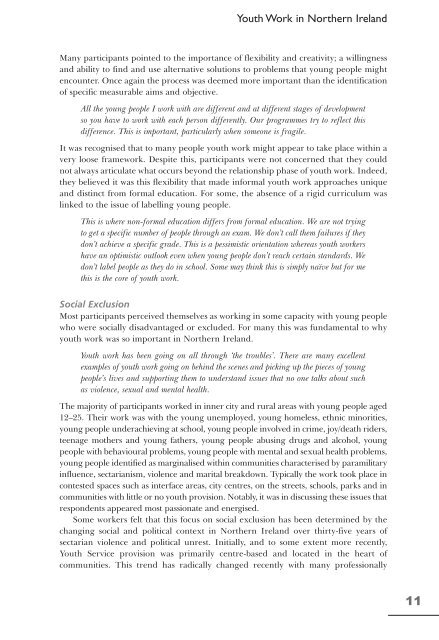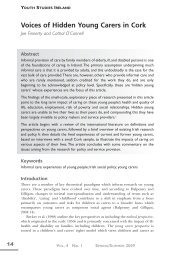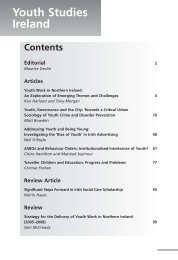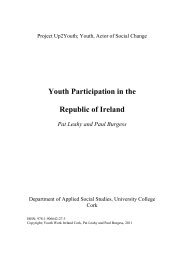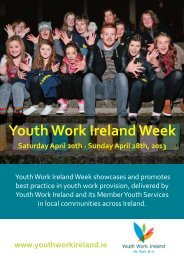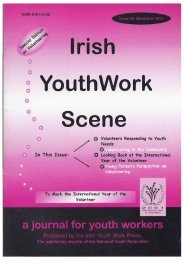Youth Work in Northern Ireland:
Youth Work in Northern Ireland:
Youth Work in Northern Ireland:
Create successful ePaper yourself
Turn your PDF publications into a flip-book with our unique Google optimized e-Paper software.
<strong>Youth</strong> <strong>Work</strong> <strong>in</strong> <strong>Northern</strong> <strong>Ireland</strong>Many participants po<strong>in</strong>ted to the importance of flexibility and creativity; a will<strong>in</strong>gnessand ability to f<strong>in</strong>d and use alternative solutions to problems that young people mightencounter. Once aga<strong>in</strong> the process was deemed more important than the identificationof specific measurable aims and objective.All the young people I work with are different and at different stages of developmentso you have to work with each person differently. Our programmes try to reflect thisdifference. This is important, particularly when someone is fragile.It was recognised that to many people youth work might appear to take place with<strong>in</strong> avery loose framework. Despite this, participants were not concerned that they couldnot always articulate what occurs beyond the relationship phase of youth work. Indeed,they believed it was this flexibility that made <strong>in</strong>formal youth work approaches uniqueand dist<strong>in</strong>ct from formal education. For some, the absence of a rigid curriculum wasl<strong>in</strong>ked to the issue of labell<strong>in</strong>g young people.This is where non-formal education differs from formal education. We are not try<strong>in</strong>gto get a specific number of people through an exam. We don’t call them failures if theydon’t achieve a specific grade. This is a pessimistic orientation whereas youth workershave an optimistic outlook even when young people don’t reach certa<strong>in</strong> standards. Wedon’t label people as they do <strong>in</strong> school. Some may th<strong>in</strong>k this is simply naïve but for methis is the core of youth work.Social ExclusionMost participants perceived themselves as work<strong>in</strong>g <strong>in</strong> some capacity with young peoplewho were socially disadvantaged or excluded. For many this was fundamental to whyyouth work was so important <strong>in</strong> <strong>Northern</strong> <strong>Ireland</strong>.<strong>Youth</strong> work has been go<strong>in</strong>g on all through ‘the troubles’. There are many excellentexamples of youth work go<strong>in</strong>g on beh<strong>in</strong>d the scenes and pick<strong>in</strong>g up the pieces of youngpeople’s lives and support<strong>in</strong>g them to understand issues that no one talks about suchas violence, sexual and mental health.The majority of participants worked <strong>in</strong> <strong>in</strong>ner city and rural areas with young people aged12–25. Their work was with the young unemployed, young homeless, ethnic m<strong>in</strong>orities,young people underachiev<strong>in</strong>g at school, young people <strong>in</strong>volved <strong>in</strong> crime, joy/death riders,teenage mothers and young fathers, young people abus<strong>in</strong>g drugs and alcohol, youngpeople with behavioural problems, young people with mental and sexual health problems,young people identified as marg<strong>in</strong>alised with<strong>in</strong> communities characterised by paramilitary<strong>in</strong>fluence, sectarianism, violence and marital breakdown. Typically the work took place <strong>in</strong>contested spaces such as <strong>in</strong>terface areas, city centres, on the streets, schools, parks and <strong>in</strong>communities with little or no youth provision. Notably, it was <strong>in</strong> discuss<strong>in</strong>g these issues thatrespondents appeared most passionate and energised.Some workers felt that this focus on social exclusion has been determ<strong>in</strong>ed by thechang<strong>in</strong>g social and political context <strong>in</strong> <strong>Northern</strong> <strong>Ireland</strong> over thirty-five years ofsectarian violence and political unrest. Initially, and to some extent more recently,<strong>Youth</strong> Service provision was primarily centre-based and located <strong>in</strong> the heart ofcommunities. This trend has radically changed recently with many professionally11


